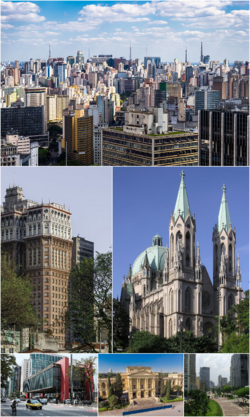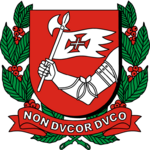Castelonovo: Difference between revisions
mNo edit summary |
|||
| Line 63: | Line 63: | ||
Today, Castelonovo is one of the most important cities of the [[Kylaris|Asterias]], since it is the political, administrative, financial and cultural centre of Belmonte where the majority of governmental institutions, banks, embassies, agencies and organizations are situated, with its name being used as a {{wp|metonymy}} for the [[Government of Belmonte|Federal Government]] as well. The city is also a cosmopolitan one, with several inhabitants coming from different regions and countries around the globe. Despite having one of the highest GDP and HDI of Belmonte, the city suffers from several social and urban problems such as high traffic, poverty, crime and pollution. | Today, Castelonovo is one of the most important cities of the [[Kylaris|Asterias]], since it is the political, administrative, financial and cultural centre of Belmonte where the majority of governmental institutions, banks, embassies, agencies and organizations are situated, with its name being used as a {{wp|metonymy}} for the [[Government of Belmonte|Federal Government]] as well. The city is also a cosmopolitan one, with several inhabitants coming from different regions and countries around the globe. Despite having one of the highest GDP and HDI of Belmonte, the city suffers from several social and urban problems such as high traffic, poverty, crime and pollution. | ||
==Etymology== | ==Etymology== | ||
The name Castelonovo comes from the junction of the words ''castelo'' and ''novo'', which means “castle” and “new” respectively, therefore meaning a new castle. Before the arrival of colonists in the region, natives called the place as ''Guyraoga'', “bird’s home”, name which was also used by the first bandeirantes that started to settle there in the 16th century. With the definitive foundation of the city, Castelonovo had its first name officialized as Castle of Saint Peter of Guyraoga and, after a fire years later, it has its name reduced to Castelonovo only. | |||
==History== | ==History== | ||
==Geography== | ==Geography== | ||
Revision as of 00:02, 9 March 2020
This article is incomplete because it is pending further input from participants, or it is a work-in-progress by one author. Please comment on this article's talk page to share your input, comments and questions. Note: To contribute to this article, you may need to seek help from the author(s) of this page. |
Castelonovo | |
|---|---|
| Município e Capital Federal de Castelonovo Municipality and Federal Capital of Castelonovo | |
 Following down left to right: downtown's skyline; Bachelet Building; the city's cathedral; Museum of Arts of Castelonovo; Mascarenhas Palace and the Guararapes' Valley. | |
| Nickname(s): Terra de Oportunidades (Land of Opportunities); Selva de Pedra (Stone's Jungle) | |
| Motto(s): Semper invicta "Always undefeated" | |
| Country | |
| Province | Federal Capital |
| Foundation | 19 May 1544 |
| Boroughs | 16 boroughs
|
| Government | |
| • Type | Mayor-council |
| • Body | Municipal Chamber |
| • Mayor | Júlio Passos |
| • Vice Mayor | Catarina Beltrão |
| Population (2019) | |
| • Total | 3,724,976 |
| Demonym | Castelan |
| Time zone | BCT |
| Area code | CST (11) |
Castelonovo ([kɐstʃelɔnovo]), officially the Municipality and Federal Capital of Castelonovo (Lusitan: Município e Capital Federal de Castelonovo), is the capital and largest city of Belmonte. According to the last demographic census made in 2018, the general population of the city and its metropolitan area corresponds to 3,724,976 inhabitants.
Founded by bandeirantes in the 16th century, Castelonovo was located between several trade routes that transported goods to villages and markets, which made the small city become within a few years an important commercial centre to the colony. Also, the rough terrain was frequently used as a natural barrier against indigenous attacks, which was another decisive factor for the upcoming centralization and transference of various public services and institutions that were formerly situated in several coastal cities to there. Soon after the Belmontese independence, the city already was the most important of the entire country, but it only became the national capital and its own province after the establishment of the republic in 1819.
With the advent of the industrial revolution, the city had one of the largest growth rates in Belmonte, with several roads and railways being built and used to connect other major cities at the same time that thousands of farmers and former slaves came to work in the new factories. In the 20th century, Castelonovo was hit with another rural exodus and political and economical instabilities, being at the centre of protests, general strikes and battles. During the Great War, the city was invaded, bombed and occupied by Entente forces until being liberated by resistance troops in the Spring March. After the war, the city was undergone through various revitalization and modernization programs and expanded considerably.
Today, Castelonovo is one of the most important cities of the Asterias, since it is the political, administrative, financial and cultural centre of Belmonte where the majority of governmental institutions, banks, embassies, agencies and organizations are situated, with its name being used as a metonymy for the Federal Government as well. The city is also a cosmopolitan one, with several inhabitants coming from different regions and countries around the globe. Despite having one of the highest GDP and HDI of Belmonte, the city suffers from several social and urban problems such as high traffic, poverty, crime and pollution.
Etymology
The name Castelonovo comes from the junction of the words castelo and novo, which means “castle” and “new” respectively, therefore meaning a new castle. Before the arrival of colonists in the region, natives called the place as Guyraoga, “bird’s home”, name which was also used by the first bandeirantes that started to settle there in the 16th century. With the definitive foundation of the city, Castelonovo had its first name officialized as Castle of Saint Peter of Guyraoga and, after a fire years later, it has its name reduced to Castelonovo only.


